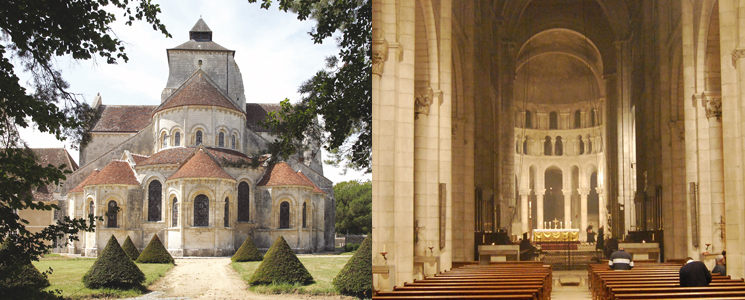By Meghan Ferrara
Located in the heart of France on the banks of the Creuse River, the ancient walls of Fontgombault hark back to the peak of medieval Christendom, its breathtaking beauty and the simplicity of monastic life. The abbey has stood the test of time, and today is the site of frequent pilgrimages, including a forthcoming one lead by Regina Magazine’s Nina Jurewicz. She recently spoke with staff writer Meghan Ferrara about the monastery and her approaching venture.
“Fontgombault is like nothing and nowhere else on Earth,” says Nina Jurewicz, an American who now makes her home in Australia. “When you are there, you never want to leave. It is always with a heavy heart when the time comes to get into the car and drive off. When you walk into the Abbey’s massive stone church, you are transported to the monastic tradition in its purest Benedictine form. This is so truly ‘foreign’ from what 99% of Catholics in the Church Militant today have experienced, because we all have grown up with the faith in a parish. A traditional, contemplative religious community is not a parish – it’s a community of men (or women) who have taken vows and spend most of their days praying for the conversion of souls worldwide.”
The inspiration for Nina’s upcoming trip to Fontgombault began the Watkinsons’ dream to found a traditional, contemplative monastery in Australia. This tradition, which plays such an integral role in the life of the church, does not exist in Australia and the Watkinsons wanted to change that.
“A monastery is greatly needed as a ‘prayer engine’ to ‘power’ and channel graces that are so desperately required for the conversion of souls,” Nina explains. “We just decided to do this by the grace of God as a grassroots effort. So through local connections and the referrals of clergy and families, we have made plans with a small group of young men who are discerning their vocations to travel to several monasteries in the US and France, so that they may experience the life there. The monastic life can only be understood by visiting monasteries. It is just too abstract to read about it in a book – you have to GO!”
Nina has many hopes for what these men will gain from this trip. It will be an excellent opportunity for them to discern their vocations in life. The group will also pray that the establishment of a contemplative community in Australia comes to fruition. There are many conditions that must first be met and such an endeavor will require much time, effort and prayer before it is realized.
For Nina, this pilgrimage also highlights the importance of monastic life. Fontgombault and other similar cloistered, monastic communities perform the essential work of hidden prayer.
“This ‘work’ of prayer is not only as important as the active apostolic work in the Church but, in some respects, even more important for the success of the New Evangelization,” she says, pointing out that such prayerful vocations are vital for two key reasons. The first is that, “Prayer is the primary and most necessary means of converting sinners and bringing souls to Christ. It is the fruit of Divine grace acting directly in a soul. Without this grace from God, all our preaching, admonishing, and penance and ready forgiveness is useless.” The second, equally important reason is because, “Monastic life is the highest form of Christian life; and the cultural witness and personal holiness of monks and monastic sisters guide and animate the building of a Christian civilization.”
Before joining Regina Magazine, Nina Jurewicz graduated with an MBA from Harvard University and worked in enterprise technology sales and professional services for over twenty years. Nina has been working to help REGINA clients reach their audiences using the Magazine, Website and Facebook Page’s original content and organic audience growth. She can be reached here.
It must be said that traditional monasteries are the lifeblood of the Church. Not only do they preserve Catholic heritage but pilgrimages to places such as Fontgombault help strengthen the Body of Christ and Holy Mother Church through meditation and prayer.
Originally established in 1091 by Pierre de l’Étoile, the Benedictine monastery thrived in the 12th and 13th centuries, leading to the formation of twenty priories.
In 1569, Calvinist Protestants demolished the church, which was not rebuilt until the end of seventeenth century by Dom Andrieu.
- The Lazarist community replaced the Benedictines in 1741, establishing a seminary there. During the French Revolution, the property suffered destruction when it was nationalized and sold off.
- The Trappists reinstituted the building as an abbey in 1849.
- In 1905, they were expelled from France under the Association Laws and the monastery was secularized and sold a second time.
- During World War I, the abbey was used as a military hospital by the Belgian army.
- From 1919 to 1948, the structure was employed as a diocesan seminary after which members of Solesmes Abbey restored it to its original role as a Benedictine community. The community thrives to this day.








.jpg)

 Abbaye Saint Paul Wisques .
Abbaye Saint Paul Wisques .
 L'abbaye Notre-Dame de Triors renoue avec un long passé monastique : en 1984, quatorze moines bénédictins de Fontgombault répondent à l'invitation qui leur est faite de s'établir dans le château de Triors construit au XVII° siècle par Charles de Lionne de Lesseins, abbé commendataire de Saint-Calais non loin de Solesmes.
L'abbaye Notre-Dame de Triors renoue avec un long passé monastique : en 1984, quatorze moines bénédictins de Fontgombault répondent à l'invitation qui leur est faite de s'établir dans le château de Triors construit au XVII° siècle par Charles de Lionne de Lesseins, abbé commendataire de Saint-Calais non loin de Solesmes.






